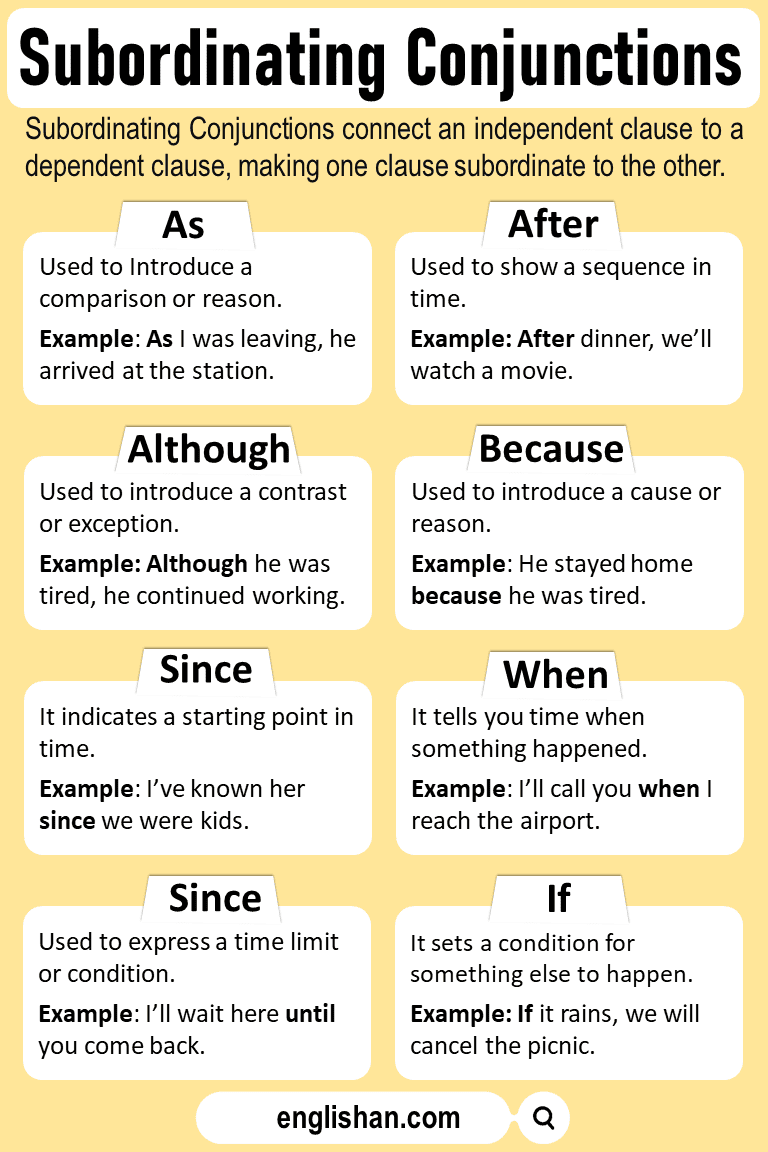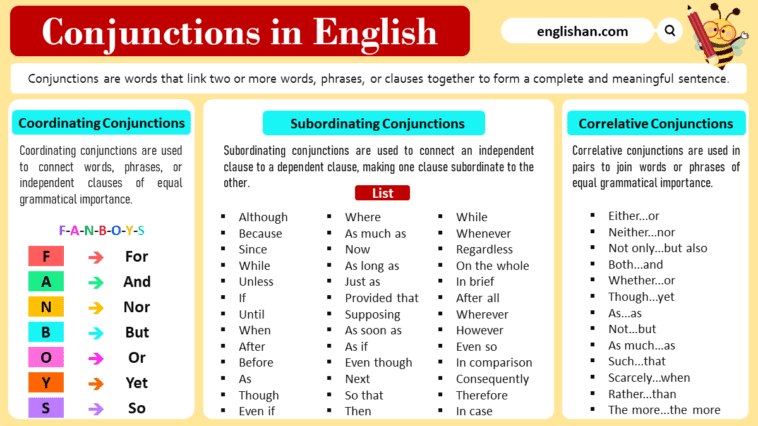Conjunctions are like little helpers in our sentences, joining words and ideas together. They might seem small, but they do big jobs. From simple words like ‘and’ and ‘but’ to fancier ones like ‘although’ and ‘however’, they help us make sense when we talk or write. In this article, we’ll explore what conjunctions are, what they do, and why they’re important for making our words flow smoothly.
What is a Conjunction?
A conjunction is a word that connects words, phrases, or clauses in a sentence. It helps to join different parts of a sentence together to show relationships between them, such as adding similar ideas (using “and”), showing contrast (using “but”), or indicating alternatives (using “or”). Conjunctions play a crucial role in making sentences clearer and more coherent by linking related thoughts or actions.
Example Sentences:
Here are some example sentences showcasing different conjunctions:
- She likes both tea and coffee.
- He’s tall, but she’s short.
- I wanted to go but it was raining.
- He is rich, yet he is unhappy.
- You can have cake or ice cream for dessert.
- She’ll either come or she’ll call.
- I’ll go to the store and buy some groceries.
- I’m tired, so I’m going to bed early.
- He is smart but lazy.
- We can go to the beach if it’s sunny.
- She didn’t study, yet she passed the exam.
- I’ll finish my work then I’ll go for a walk.
- He wanted to go out but he had no money.
- She’s happy because she got a promotion.
- I’m going to the party although I’m tired.
- He likes swimming as well as diving.
- I’ll go to the gym or I’ll go for a run.
- He was sick so he stayed home.
- She ran fast and won the race.
- I’ll help you if you ask nicely.
- She is busy yet she finds time to read.
- He neither eats meat nor drinks alcohol.
- I’ll finish my homework before I watch TV.
- They’ll go to the concert unless it’s too expensive.
- She’ll come once she finishes her chores.
- He works hard but he never complains.
- We’ll go to the beach although it’s cold.
- She likes both chocolate and vanilla ice cream.
- I’ll call you when I arrive.
- He’ll either play soccer or basketball tonight.
List of Conjunction
Here’s a list of common conjunction:
- and
- or
- but
- yet
- so
- for
- nor
- although
- because
- since
- while
- when
- before
- after
- if
- unless
- whether
- either
- neither
- both
- as
- as if
- as though
- even though
- provided
- so that
- in order that
- than
- as well as
- like
- as if
- as though
- once
- since
- now that
- as long as
- so long as
- whether or not
- just as
- even if
- whereas
- wherefore
- inasmuch as
- given that
- now
- then
- but then
- then again
- though
- albeit
- notwithstanding
- however
- nevertheless
- nonetheless
- still
- yet
- whereas
- conversely
- on the other hand
- despite
- in spite of
- regardless
- in any case
- all the same
- granted
- notwithstanding
- for all that
- with this in mind
- hence
- thus
- therefore
- consequently
- as a result
- accordingly
- as such
- then
- as a consequence
- for this reason
- in conclusion
- finally
- in sum
- to sum up
- on the whole
- in short
- all in all
- by and large
- in the final analysis
- considering this
- taking everything into account
- altogether
- overall
- in essence
- to conclude
- as a whole
- briefly
- to summarize
- to put it briefly
- to summarize
- to sum up
- henceforth
- thereafter
- subsequently
- subsequently to
- afterward
- posthumously
- later
- then
- next
- first
- second
- third
- fourth
- finally
- lastly
- after a while
- soon
- presently
- momentarily
- in a moment
- immediately
- shortly
- forthwith
- in no time
- without delay
- at once
- instantly
- right away
- on time
- punctually
- later on
- afterward
- eventually
- at length
- sooner or later
- in due course
- in time
- over time
- gradually
- step by step
- bit by bit
- little by little
- by degrees
- slowly but surely
- by and by
- at that moment
- at that point
- at that time
- then
- when
- while
- as
- until
- till
- during
- before
- after
- since
- whenever
- as soon as
- the moment
- the instant
- as long as
- once
- just as
- no sooner than
- barely
- hardly
- scarcely
- just
- nearly
- almost
- about
- approximately
- around
- roughly
- more or less
- in the vicinity of
- somewhere around
- close to
- near
- by
- adjacent to
- bordering on
- touching on
- besides
- furthermore
- moreover
- additionally
- also
- as well
- further
- to boot
- in addition
- not only
- but also
- equally
- likewise
- equally important
- similarly
- likewise
Conjunction Rules
Conjunctions are a crucial part of English grammar, linking words, phrases, or clauses together to form coherent sentences. Here are some important rules and guidelines for using conjunctions effectively:
- Joining Words:
- Conjunctions are like little bridges that connect words or ideas in a sentence.
- Different Types:
- There are different kinds of conjunctions for different jobs. Some are for joining similar things, like “and” or “or.” Others are for showing contrast, like “but.”
- Making Sentences Clear:
- Conjunctions help make sentences clear and understandable by showing how different parts of a sentence relate to each other.
- Use Commas with Care:
- When you use a conjunction to join two sentences, you usually put a comma before it to keep things clear.
- Keep Things Balanced:
- When you’re using conjunctions to list things, make sure they’re all in the same form to keep your sentence balanced and easy to follow.
- Avoiding Confusion:
- Be careful not to use a comma by itself to join two sentences. It might confuse people. Instead, use a conjunction or a semicolon.
- Choose the Right Conjunction:
- Pick the conjunction that fits the relationship between the ideas you’re connecting. Whether it’s adding information, showing contrast, or explaining cause and effect, choose the right one for the job.
Remembering these simple rules can help you use conjunctions effectively to improve your writing and make your sentences clearer.
Types of Conjunction
Conjunctions are words that connect words, phrases, or clauses within a sentence. Here are the main types of conjunctions:
Coordinating Conjunctions
These join words, phrases, or independent clauses of equal importance. The common coordinating conjunctions are:
- For
- And
- Nor
- But
- Or
- Yet
- So

Subordinating Conjunctions
These introduce dependent clauses, which cannot stand alone as complete sentences. They indicate the relationship between the dependent clause and the independent clause. Examples include:
- After
- Although
- Because
- Since
- When
- While

Correlative Conjunctions
These are pairs of conjunctions that work together to join words or groups of words in a sentence. The common correlative conjunctions include:
- Either…or
- Neither…nor
- Both…and
- Not only…but also
- Whether…or
Each type of conjunction serves a specific purpose in connecting elements within sentences to convey meaning effectively.
Use of Conjunction
The use of conjunctions is crucial in language to connect words, phrases, or clauses within a sentence. Here are some key ways in which conjunctions are used:
- Joining Words: Conjunctions link individual words within a sentence. For example:
- “I like tea and coffee.”
- “She is tall but slim.”
- “He is neither tall nor slim.”
- Connecting Phrases: Conjunctions also connect phrases to create more complex sentence structures. For example:
- “She went to the store after work.”
- “He plays soccer as if he’s a professional.”
- “They enjoyed the movie because of its thrilling plot.”
- Combining Clauses: Conjunctions join independent clauses to form compound sentences or connect dependent clauses to independent clauses. For example:
- Compound Sentence: “He likes to read, and she likes to write.”
- Complex Sentence: “I will go to the park if the weather is nice.”
- Expressing Relationships: Conjunctions convey various relationships between the connected elements, such as addition, contrast, reason, condition, time, and purpose. For example:
- Addition: “He and she are siblings.”
- Contrast: “It’s raining but we’re still going out.”
- Reason: “She is studying hard because she wants to pass the exam.”
- Condition: “If it snows, we will build a snowman.”
- Time: “She will call when she arrives.”
- Purpose: “He went to the store to buy some groceries.”
- Forming Lists: Conjunctions are used to connect items in a list. For example:
- “I bought apples, bananas, and oranges.”
- “She can speak English, French, and Spanish.”
Overall, conjunctions play a vital role in creating coherent and structured sentences by linking various elements and expressing relationships between them.
Common Mistakes
Common mistakes related to conjunctions often involve their misuse or improper placement within a sentence. Here are a few examples:
You May Also Like:
- Conjunctions Worksheets and Exercises With Answers in English
- Parts of Speech
- Till, Until and Unless
- Clause Analysis
- Dependent Clauses



